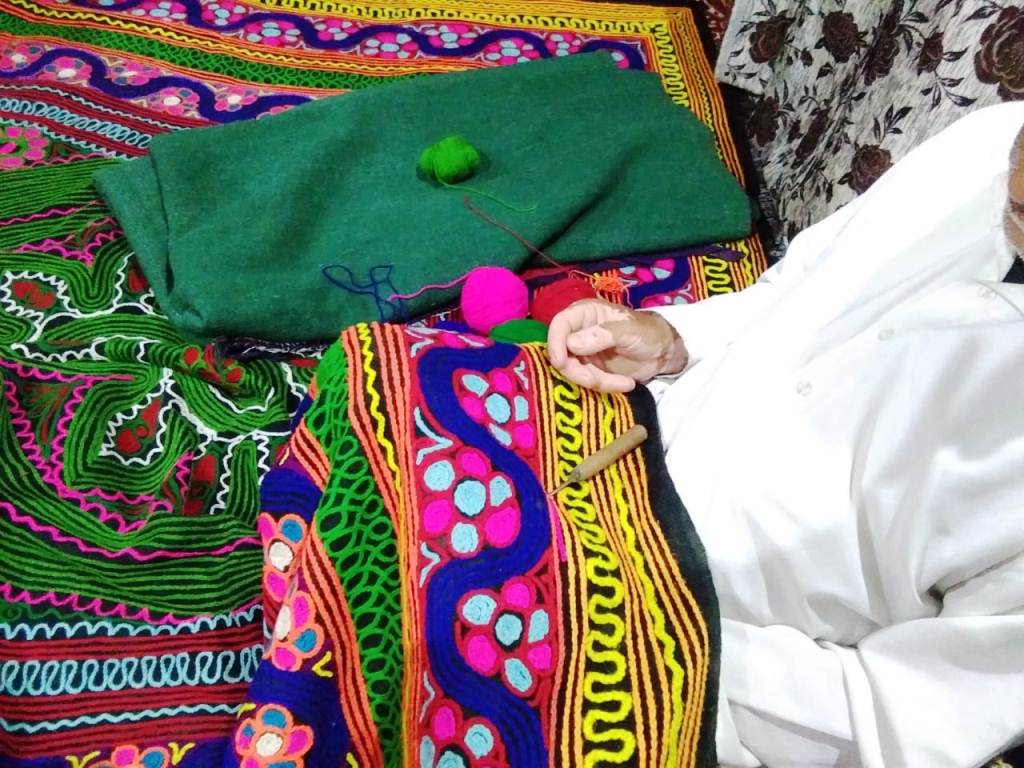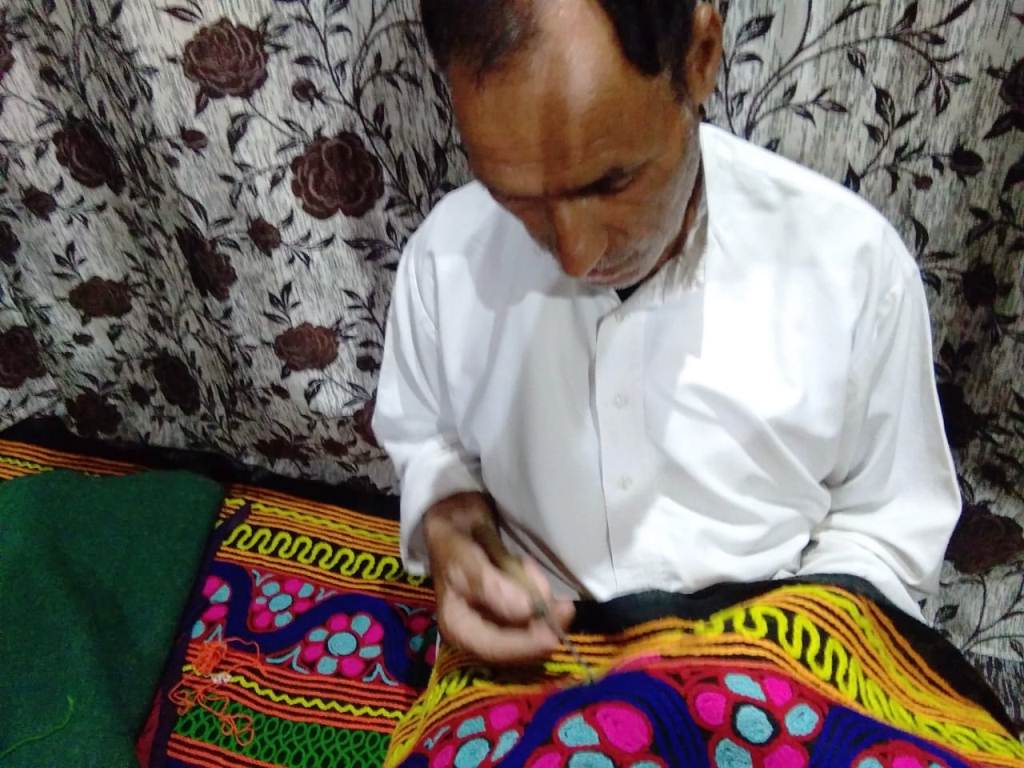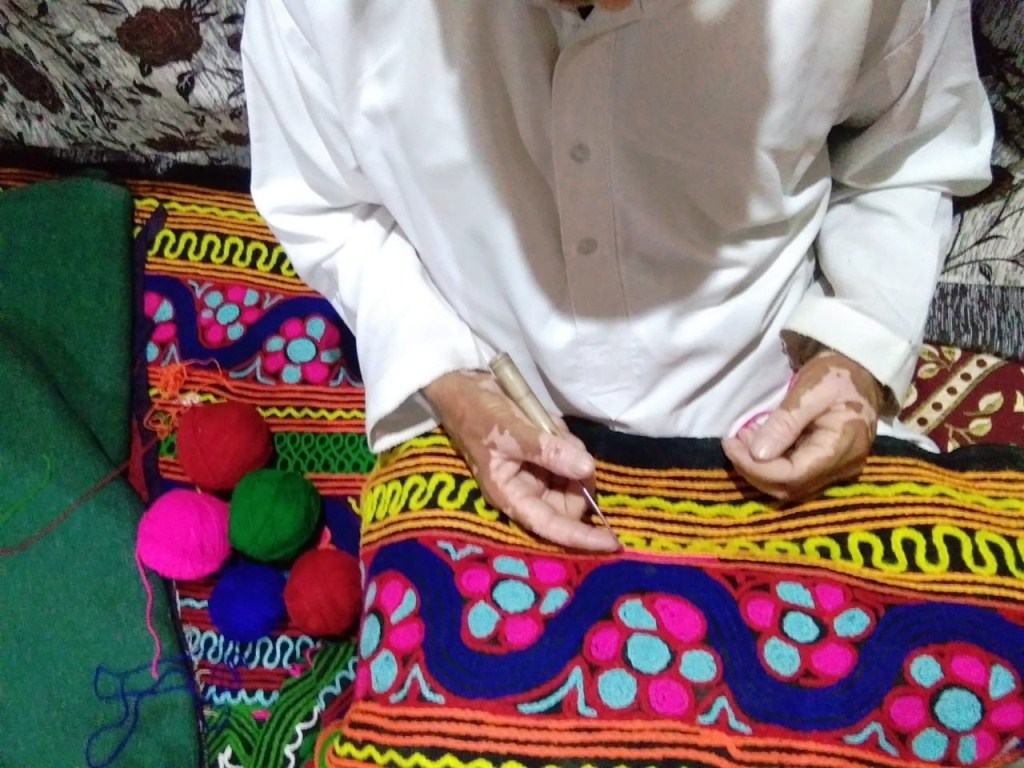Rugmaker’s Resolve Rebranding Kashmiri ‘Gabe’

Bisma Farooq is a Staff Writer at the Mountain Ink.
Among the cultural symbols which have faded in the guise of modernity is an iconic Kashmiri rug called ‘Gabe’. But now, fighting this craft demise is a master artisan once again decorating Kashmiri drawing rooms with the revived rug.
Change which Ghulam Mohammad Lone had long craved for has already taken place to his contentment. The rug which once graced Kashmiri drawing rooms has resuscitated with compelling colours and creative touches.
Behind this rebranding of the Kashmiri traditional mat called ‘Gabe’, is the silent workmanship of the 63-year-old Kashmiri embroidery rug-artist.
Hailing from Sonawari’s Naidkhai area, Lone is one of the famed artisans of Kashmir’s fading cottage industry. This son of Hamza Lone, one of the ace artisans of his time, always enjoyed the reputation of a master craftsman among his folks in his artisan-abode hamlet. But that was till his tribe hadn’t dispersed for other means of living due to the falling market.
“When everyone started abandoning the sinking ship, someone had to play a captain for the sake of survival,” he strikes a deep-philosophical chord to convey his point.
As part of Kashmir’s cultural diversity, Lone’s skill-specialization was always in embroidered rugs. With his forty-odd years of experience, he decided to work on the beautiful patterns as part of his rebranding strategy when the craft demise looked imminent. It worked.
Support Our Journalism
You are reading this because you value quality and serious journalism.
But, serious journalism needs serious support. We need readers like you to support us and pay for making quality and independent journalism more vibrant.
Back in Kashmir capital, street salesmen would throng neighbourhoods with these colourful rugs and eventually, they began gracing guest rooms once again.
Apart from giving that ethnic look to modern Kashmiri houses, these hand-embroidered rugs— decorated with colourful threads—became artistic showpieces in their rebranded avatar.

Back in his home-based workplace, Lone talks about the making of a Kashmiri rug and its multiple stages. It includes a step where threads are made through Yendir—spinning wheel.
Yendir gives a fine thread which is used in Aari needle and then the designs are printed on the cloth or woollen mat.
The mat or the cloth is then embroidered by an artist and after its completion—it takes an artist almost 15 days to complete a piece of art—the market consumption begins.
“It was my father who introduced me to the art of making Kashmiri embroidered rugs,” Lone continues. “When he died, he took a promise from me that I won’t leave it. I’ve lived by that promise and even now when this art is dying, I’m still working and earning a good livelihood from it.”

Before Lone’s show-of-skill would make this Kashmiri rug fashionable again, the drawing rooms in the valley would be mostly decorated by the classic—affordable—‘Gabe’. Since the carpets were costly, these Kashmiri embroidered rugs were in high demand.
“They were popular among all classes of people in Kashmir,” the master artisan says. “But sadly, they slowly got replaced by machine-made rugs and carpets.” Eventually, as the market tumbled, artisans switched over to other means of living.
But the likes of Lone stayed put—one, for the sake of upholding his pledge made to his dying father, and second, for the love of the art.
“As a child, I would see my father making rugs and earning a goodwill and livelihood,” he recounts. “Fascinated by the work, good customer response and respect towards the craft, I chose to be a rug-maker during my early teen only.”


As a proud artisan, Lone says, he has always earned his bread by working hard. These days, he works for a Kashmiri art dealer from Srinagar. His colourful patterns have only recreated an urban fascination for Kashmiri ‘Gabe’.
“I have this dream to have my own art school now where I can train students and save this art and culture of Kashmir from extinction.”
In the era of technology, Lone believes, an artisan can do wonders. “I hope there’s a way through technology where people can be made aware about these Kashmiri embroidered rugs, so that people will be reminded about our culture.”
Already, he has mentored many young boys and girls, but most of them, he says, couldn’t continue because of the lack of market and official support.
“But despite all this,” he hopes, “unemployed Kashmiri boys and girls should learn to make Kashmiri embroidered rugs. It’ll become their source of income and will eventually preserve the art and culture of Kashmir.”
Mountain Ink is now on Telegram. Subscribe here.
Become Our Ally
To help us strengthen the tradition of quality reading and writing, we need allies like YOU. Subscribe to us.










